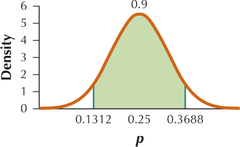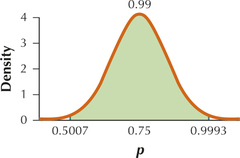7.4 Section 7.2 Exercises
CLARIFYING THE CONCEPTS
Question 7.127
1. Explain what a sample proportion is, using as an example the courses for which you got an A last semester. (p. 415)
7.2.1
If we take a sample of size n, the sample proportion ˆp is ˆp=x/n, where x represents the number of individuals in the sample that have the particular characteristic. Examples will vary.
Question 7.128
2. What is the mean of the sampling distribution of ˆp? (p. 416)
Question 7.129
3. Give the formula for the standard error of the proportion. (p. 416)
7.2.3
σˆp=√p⋅(1−p)/n
Question 7.130
4. What are the requirements for the sampling distribution of ˆp to be approximately normal? (p. 417)
Question 7.131
5. Suppose you double the sample size. What happens to the standard error of the proportion? (p. 416)
7.2.5
It decreases by a factor of 1/√2≈0.7071.
Question 7.132
6. For the following values of X and n, calculate the sample proportion ˆp: (p. 415)
- X=10, n=40
- X=25, n=75
- Number of successes=27, number of trials=54
- Number of successes=1000, number of trails=1 million
PRACTICING THE TECHNIQUES
 CHECK IT OUT!
CHECK IT OUT!
| To do | Check out | Topic |
|---|---|---|
| Exercises 7–18 | Example 12 | Determining whether the CLT for Proportions applies |
| Exercises 19–24 | Example 13 | Minimum sample size for approximating normality |
| Exercises 25–32 | Example 14 | Finding probabilities using the CLT for Proportions |
| Exercises 33–38 | Example 15 | Finding percentiles using the CLT for Proportions |
In Exercises 7–18, samples are taken. Find (a) μˆp and (b) σˆp, and (c) determine whether the sampling distribution of ˆp is approximately normal or unknown.
Question 7.133
7. p=0.5, n=400
7.2.7
(a) 0.5 (b) 0.025 (c) Approximately normal
Question 7.134
8. p=0.5, n=20
Question 7.135
9. p=0.05, n=200
7.2.9
(a) 0.05 (b) 0.01541 (c) Approximately normal
Question 7.136
10. p=0.05, n=100
Question 7.137
11. p=0.3, n=12
7.2.11
(a) 0.3 (b) 0.1323 (c) Unknown
Question 7.138
12. p=0.3, n=20
Question 7.139
13. p=0.002, n=2000
7.2.13
(a) 0.002 (b) 0.000999 (c) Unknown
Question 7.140
14. p=0.002, n=2500
Question 7.141
15. p=0.02, n=250
7.2.15
(a) 0.02 (b) 0.008854 (c) Approximately normal
Question 7.142
16. p=0.02, n=200
Question 7.143
17. p=0.01, n=500
7.2.17
(a) 0.01 (b) 0.004450 (c) Approximately normal
Question 7.144
18. p=0.01, n=100
In Exercises 19–24, find the minimum sample size that produces a sampling distribution of ˆp that is approximately normal.
Question 7.145
19. p=0.8
7.2.19
25
Question 7.146
20. p=0.85
Question 7.147
21. p=0.9
7.2.21
50
Question 7.148
22. p=0.95
Question 7.149
23. p=0.99
7.2.23
500
Question 7.150
24. p=0.999
For Exercises 25–32, if possible, find the indicated probability. If it is not possible, explain why not.
Question 7.151
25. p=0.5, n=225, P(ˆp>0.55)
7.2.25
0.0668
Question 7.152
26. p=0.5, n=8, P(ˆp>0.55)
Question 7.153
27. p=0.03, n=36, P(ˆp>0.011)
7.2.27
Not possible since n⋅p=(36)(0.03)=1.08<5.
Question 7.154
28. p=0.03, n=225, P(ˆp>0.011)
Question 7.155
29. p=0.8, n=50, P(0.88< ˆp<0.91)
7.2.29
0.0531
Question 7.156
30. p=0.8, n=81, P(0.88< ˆp<0.91)
Question 7.157
31. p=0.98, n=225, P(ˆp >0.981)
7.2.31
Not possible since n⋅q=(225)(0.02)=4.50<5.
Question 7.158
32. p=0.98, n=256, P(ˆp >0.981)
For Exercises 33–38, find the indicated value of ˆp. If it is not possible, explain why not.
Question 7.159
33. p=0.6, n=100, value of ˆp larger than 90% of all values of ˆp
7.2.33
0.6628
Question 7.160
34. p=0.6, n=100, value of ˆp larger than 10% of all values of ˆp
Question 7.161
35. p=0.99, n=225, 95th percentile of values of ˆp
7.2.35
Not possible since n⋅q=(225)(0.01)=2.25<5.
Question 7.162
36. p=0.99, n=225, 5th percentile of values of ˆp
Question 7.163
37. p=0.2, n=225, 2.5th percentile of values of ˆp
7.2.37
0.1477
Question 7.164
38. p=0.2, n=225, 97.5th percentile of values of ˆp
APPLYING THE CONCEPTS
Question 7.165
39. Abandoning Landlines. The National Health Interview Survey reports that 25% of telephone users no longer use landlines, and have switched completely to cell phone use. Suppose we take samples of size 36.
- Find the mean and standard error of the sampling distribution of ˆp, the sample proportion of telephone users who no longer use landlines.
- Describe the sampling distribution of ˆp.
- Compute the probability that ˆp exceeds 0.26.
7.2.39
(a) μˆp=0.25,σˆp≈0.0722 (b) Approximately normal (0.25, 0.0722) (c) 0.4443 (TI-83/84: 0.4449)
Question 7.166
40. LeBron James. During the 2013-2014 National Basketball Association season, 75% of LeBron James's free throws were successful. Suppose we take a sample of 50 of LeBron's free throws.
- Find μˆp and σˆp for the sample proportion of LeBron's free throws that were good.
- Describe the sampling distribution of ˆp.
- Calculate P(ˆp>0.60).
Question 7.167
41. Small Business Jobs. According to the U.S. Small Business Administration, small businesses provide 75% of the new jobs added to the economy. Suppose we take samples of 20 new jobs.
- Find μˆp and σˆp for the sample proportion of new jobs added to the economy that are provided by small businesses.
- Calculate P(ˆp>0.69).
- Compute P(0.775< ˆp < 0.8).
7.2.41
(a) μˆp=0.75,σˆp≈0.0968 (b) 0.7324 (TI-83/84: 0.7323) (c) 0.0959 (TI-83/84: 0.0954)
Question 7.168
42. Facebook Accounts. In 2014, the Harvard University Institute of Politics surveyed 3058 people 18 to 29 years old and found 2569 who had a Facebook account.7 Suppose we take samples of 256 18- to 29-year-olds.
- Find μˆp and σˆp for the sample proportion of 18- to 29-year-olds with Facebook accounts.
- Calculate P(ˆp>0.86).
- Compute P(0.82 <ˆp<0.86).
Question 7.169
43. Abandoning Landlines. Refer to Exercise 39.
- Find the 5th and 95th percentiles of the sample proportions.
- Draw a graph showing the sampling distribution of ˆp, centered at p, with the 5th and 95th percentiles, and the area of 0.90 under the curve between them shaded.
- Suppose only 2 of 36 phone users in a sample abandoned their landlines. Would this be considered an outlier? Explain your reasoning. (Hint: Use the Z-score method.)
- Determine which sample proportions would be considered outliers.
7.2.43
(a) 0.1312, 0.3688
(b)

(c) For ˆp=2/36≈0.0556, Z=−2.69. Thus ˆp=2/36 is considered moderately unusual. (d) Sample proportions between 0 and 0.0334 inclusive and between 0.4666 and 1 inclusive would be considered outliers.
Question 7.170
44. LeBron James. Refer to Exercise 40.
- Find the 2.5th and 97.5th percentiles of the sample proportions.
- Draw a graph showing the sampling distribution of ˆp, centered at p, with the 2.5th and 97.5th percentiles, and the area of 0.95 under the curve between them shaded.
- In the May 20, 2014 playoff game against the Indiana Pacers, LeBron James had only a 50% success rate from the free-throw line. Would that be considered “poor shooting” by his standards? Explain your reasoning. (Hint: Use the Z-score method.)
- Later in the same series, in the May 30, 2014 playoff game against the Indiana Pacers, LeBron James had a perfect 100% success rate from the free-throw line. Would that be considered “hot shooting” by his standards? Explain your reasoning.
Question 7.171
45. Small Business Jobs. Refer to Exercise 41.
- Find the 0.5th and 99.5th percentiles of the sample proportions.Page 423
- Draw a graph showing the sampling distribution of ˆp, with the area between the 0.5th and 99.5th percentiles shaded.
- Suppose 14 of 20 new jobs added to the economy were provided by small business. Would this be considered unusual? Explain your reasoning.
7.2.45
(a) 0.5003, 0.9997 (TI-83/84: 0.5007, 0.9993)
(b)

(c) For ˆp=14/20=0.7,Z=−0.5165. Thus ˆp=0.7 is neither moderately unusual nor an outlier.
Question 7.172
46. Facebook Accounts. Refer to Exercise 42.
- Find the 2.5th and 97.5th percentiles of the sample proportions.
- Draw a graph showing the sampling distribution of ˆp, with the area between the 2.5th and 97.5th percentiles shaded.
- Calculate P(ˆp<0.82).
- Suppose someone claimed that the proportion of all 18- to 29-year-olds who had a Facebook account was less than 0.82. Based on the probability you calculated in (c), do you think there is strong evidence against this claim?
Question 7.173
 47. Facebook Accounts. Refer to Exercises 42 and 46. What if we increased the sample size to some unspecified larger number? Describe how and why the following quantities would change, if at all:
47. Facebook Accounts. Refer to Exercises 42 and 46. What if we increased the sample size to some unspecified larger number? Describe how and why the following quantities would change, if at all:
- μˆp
- σˆp
- P(ˆp>0.86)
- P(0.82<ˆp<0.86)
- P(ˆp<0.82)
- 2.5th percentile of the sample proportions
- 97.5th percentile of the sample proportions
7.2.47
(a) Remains the same since μˆp=p does not depend on n.
(b) Decrease. Since the sample size n is in the denominator of σˆp=√p⋅qn, σˆp decreases as the sample size n increases. (c) Decrease. Standardizing we get Z=0.86−μˆpσˆp=0.86−0.840σˆp=0.02σˆp. From (b), σˆp decreases as the sample size n increases. Therefore Z=0.02σˆp increases as the sample size n increases. Therefore P(ˆp>0.86)=P(Z>0.02σˆp) decreases.
(d) Increase. Standardizing we get Z=0.82−μˆpσˆp=0.82−0.840σˆp=−0.02σˆp and Z=0.86−μˆpσˆp=0.86−0.840σˆp=0.02σˆp. From (b), σˆp decreases as the sample size n increases. Therefore Z=−0.02σˆp decreases and Z=0.02σˆp increases as the sample size n increases. Thus P(0.82<ˆp<0.86)=P(−0.02σˆp<Z<0.02σˆp) increases as the sample size n increases. (e) Decrease. Standardizing we get Z=0.82−μˆpσˆp=0.82−0.840σˆp=−0.02σˆp. From (b), σˆp decreases as the sample size n increases. Therefore Z=−0.02σˆp decreases as the sample size n increases. Thus P(ˆp<0.82)=P(Z<−0.02σˆp) decreases as the sample size n increases. (f) Increase. The 2.5th percentile is found by the formula ˆp1=(−1.96)σˆp+μˆp. From (a) μˆp remains the same as the sample size n increases and from (b) σˆp decreases as the sample size n increases. Therefore ˆp1=(−1.96)σˆp+μˆp increases as the sample size n increases. (g) Decrease. The 97.5th percentile is found by the formula ˆp2=(−1.96)σˆp+μˆp. From (a) μˆp remains the same as the sample size n increases and from (b), σˆp decreases as the sample size n increases. Therefore ˆp2=(−1.96)σˆp+μˆp decreases as the sample size n increases.
BRINGING IT ALL TOGETHER
Partners Checking Up on Each Other. Use the following information for Exercises 48–51. According to a study in the journal Computers in Human Behavior,8 65% of the college women surveyed checked the call histories on the cell phones of their partners, whereas 41% of the males did so.
Question 7.174
48. Suppose we take a sample of 100 college females and 100 college males.
- Find μˆp and σˆp for the sample proportion of females checking the call histories of their partners.
- Find μˆp and σˆp for the sample proportion of males checking the call histories of their partners.
Question 7.175
49. Refer to Exercise 48. Calculate the following probabilities:
- That more than 65% of the females checked the call histories of their partners
- That more than 65% of the males checked the call histories of their partners
- That less than 41% of the females checked the call histories of their partners
- That less than 41% of the males checked the call histories of their partners
7.2.49
(a) 0.5 (b) 0 (c) 0 (d) 0.5
Question 7.176
50. Refer to Exercise 48.
- Find the 2.5th and 97.5th percentiles of the sample proportions of females checking the call histories of their partners.
- Find the 2.5th and 97.5th percentiles of the sample proportions of males checking the call histories of their partners.
Question 7.177
51. Suppose someone claimed that there really was no difference in the proportions of females and males who check the call histories on their partners' cell phones. How would you use the results from Exercises 49 and 50 to address this claim?
7.2.51
The results of Exercises 49 and 50 do not support this claim. The 97.5th percentile for the males is less than the 2.5th percentile for the females. Also P(p<0.41) and P(p>0.65) are both very different for males and females.